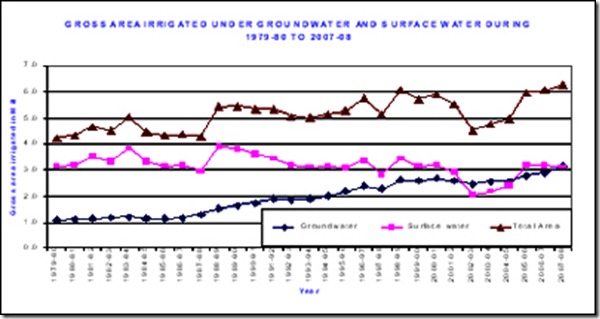|
INTRODUCTION TOP
About the Department
OBJECTIVES TOP The main goal of the Ground Water Department is scientific development, systematic management and optimal monitoring of groundwater resources for sustainability. FUNCTIONS TOP
ABOUT ANDHRA PRADESH TOP I. Introduction II. Availability of Groundwater Nearly 85% of the State is underlain by hard rocks and the chief contributors of groundwater in these rocks are the fractured systems. These fractured systems as mentioned above are not uniformly distributed and have limited aerial and depth extent. Rainfall is the source of recharge to groundwater and during the last decade this source has become erratic and some times very low. The number of rainy days has also come down. Thus the recharge to groundwater bodies has come down. Apart from this people are resorting to use groundwater more often because, it is economical, easily available and consumes less time to ground a project, in view of the limited surface water resources and their uneven distribution. Thus the strain on groundwater aquifers mostly in upland areas is increasing day by day. III. Future Scenario CITIZENS CHARTER:TOP Under Citizens Charter, the department undertakes Customer Services, attends to Public Grievances related matters and tries to redress them from time to time. TRENDS IN GROUNDWATER DEVELOPMENT TOP
CHANGING GROUNDWATER SCENARIO IN HARD ROCK HYDRO SYSTEMS
GROSS AREA IRRIGATED UNDER DIFFERENT SOURCES-Graph GROUNDWATER MONITORING NETWORK:
GEOLOGY & PIEZOMETER NETWORK IN A.P TOP COMMAND AREA DEVELOPMENT
WATER QUALITY
PROGRAMS TAKENUP BY THE DEPARTMENTTOP Groundwater Management Estimation
Assessment of Groundwater resources
CATEGORISATION OF BASINS IN A DISTRICT
GROUNDWATER RESOURCE IN ANDHRA PRADESH EXTERNALLY AIDED PROJECTS TOP Externally aided projects are of great help to the Ground Water Department in enhancing its capabilities for furthering the development and management of Ground Water Resources in the State. HYDROLOGY PROJECT-I (completed) The World Bank Assisted Hydrology Project has been successfully implemented by the Government of Andhra Pradesh since 1996 on words with a basic project cost of Rs.14.81 crores and revised to Rs.31.00 crores. This project’s objective is to improve the institutional and organizational arrangements, technical capabilities and physical facilities available for measurement, validation, collation, analysis, transfer and dissemination of Hydrological, Hydro meteorological and Water Quality data for basic water resource evaluation. The project components were aimed at:
Implementation of the project has resulted in
HYDROLOGY PROJECT-II (on going) World Bank Assisted Hydrology Project Phase-II is a sequel to Hydrology Project-I, will build on and expand development of a comprehensive Hydrological Information System (HIS), for improving access and use by user departments, civil society and other data users in the sector, thereby intensifying the use of HIS in effective and efficient water resources planning and management. The project development objective will be to extent and promote the sustained and effective use of the HIS by all potential users concerned with water resources planning and management, both public and private, thereby contributing to improved productivity and cost effectiveness of water related investments. Project components related to AP Ground Water
ROLE OF HYDROLOGICAL DATA USERS GROUP (HDUG) & HYDROLOGICAL INFORMATION SYSTEM (HIS) The World Bank funded Hydrology Project Phase-II is being implemented in the state. “Organization of dissemination workshop to inform others including the policy makers the importance of having good quality data and information” “Dedicated Monitoring and Evaluation focal staff to start working towards assessing the performance of HIS”.
Originally Hydrological Data Users Group constituted during HP-I vide Apart from the above Govt. of A.P. accorded permission for formulation of District Level HDUG under HP-II, under the chairmanship of District Collector. The objective is to create awareness among users about HIS AWARENESS PROGRAMMES & DATA DISSEMINATIONTOP APGWD creating awareness among farming community and water users about the management of water resource available in their areas.
DISSEMINATION OF DATA This department has provided water levels status, water quality data, groundwater potentials etc., to
II. Organisations like
III. Research scholars and M.Tech students from
IV. To many individual students, consultants who are working on groundwater related studies. Abstract of User charges / Data charges for providing water level, water quality data, GEC data and Maps to different users
II. GEC Data: It is a World Bank and Govt. of India assisted multi dimensional project for restoration of Minor Irrigation tanks where in groundwater component has been included. It envisages demarcation of zone of influence of the tanks and management of groundwater by the community. The Groundwater component outlay is Rs 40 crores spread over 5 years from 2007-08 onwards. About 1200 MI tanks covering 300 groundwater assessment units is likely to be covered under the project AP WALTATOP An act to promote water conservation and tree cover and regulate the exploitation and use of groundwater & surface water for protection and conservation of water sources, land and environment and matters connected therewith, or incidental thereto. Salient Features:
Walta – 2004( amendments)
RAIN WATER HARVESTING FOR ARTIFICIAL RECHARGE Simple low cost methods are suggested to collect and store runoff water, from the roof tops of buildings, road surfaces, municipal parks, school play grounds, stadiums, air ports etc, in recharge pits for artificial recharge. Such measures help in reducing the urban runoff, decrease pollution of groundwater and increase the groundwater recharge which facilities to augment the yields of wells. The methods suggested are water spreading, recharge through pits, trenches, wells, shafts and directly diverting runoff water into the existing wells . ORGANOGRAM TOP Sri B.M.MURALI KRISHNA RAO, M.Tech,F.I.E, C.Eng(I) STATUS OF WORKS TAKEN UP BY GROUND WATER DEPARTMENT TOP The progress for the Year (2011-2012)
The Financial allocations & Expenditure during 2010-2011, financial year (2011-2012) (Rs.lakhs)
STATISTICS OF ANDHRA PRADESH TOP
DISTRICT WISE WATER LEVELS IN A.P TOP DISTRICT WISE WATER LEVELS IN A.P
Depth to Ground Water Levels in Andhra Pradesh-Map TOP Ground Water Level Fluctuations in Andhra Pradesh-MapsTOP |
Source: APOnline – Organisation Info










